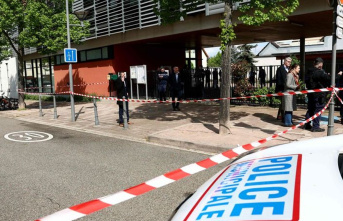It's about anchorages, pillars, axles, threaded rods, side members and much more: Since Monday, the Schweinfurt district court has had to clarify who is to blame for the collapse of a section of a freshly concreted motorway bridge in Bavaria in June 2016. At that time, a construction worker died and 14 others were injured. The lawyers face a lengthy process that is complex even for construction experts.
Right at the beginning of the hearing before the Great Criminal Court of the Schweinfurt Regional Court, the defense attorneys make it clear that they will face a lot of opposition in the process. The lawyers of two of the four accused reject the court-appointed building surveyor, who is supposed to name the possible cause of the collapse in his report. The expert opinion is unusable for many reasons, says the defense attorney of a 65-year-old accused.
The expert lacks objectivity and neutrality as well as expertise - he is not an expert in steel construction. "Due to a lack of his own expertise, he was dependent on the expertise of third parties." However, the predominant preparation of the expert opinion by assistants is inadmissible. "There is a strict ban on delegations. (...) The preparation of an expert opinion is a highly personal obligation," warns the lawyer. Another lawyer makes the application to reject the building surveyor because of possible bias - but the prosecution sees no reason for this.
A 38-year-old construction worker dies in the collapse
It is June 15, 2016. Around 1,500 tons of concrete have just been poured into the new Schraudenbach Viaduct on Autobahn 7 near Werneck in the Schweinfurt district when the shoring gives way. "During the collapse, 13 construction workers were dragged about 22 meters down," senior public prosecutor Reinhold Emmert reads out the indictment. Together with the components made of concrete, wood and steel, the men fall into the abyss. A 38-year-old worker - father of two children - dies. 14 other people are injured, three of them life-threatening. What remains is a huge heap of rubble made of steel pipes, long metal cables, steel girders and countless scaffolding parts - meters high in semi-solid concrete.
The public prosecutor accuses two 49 and 65-year-old engineers and a structural engineer (51) of negligent homicide and negligent bodily harm in 14 cases. Another engineer, 59, is on trial for manslaughter by omission and bodily harm by omission.
The 51-year-old is said to have calculated the statics of the shoring construction and created the execution drawings. He is said to have made mistakes - and as a result the scaffolding should not have been stable enough.
The 59-year-old is on trial because, according to the public prosecutor's office, he, as the auditor appointed by the Free State of Bavaria, is practically not concerned with the matter and is said to have illegally passed the matter on to the 65-year-old subcontractor who was also accused. This in turn is said to have transferred the work to his employee, the 49-year-old. According to the prosecutors, all three could and should have recognized the errors in the structural design and calculation.
Eleven days of negotiations are scheduled until April
At the beginning of the trial, the defense attorney for the 59-year-old first approached the public prosecutor. "I believe that the investigation was completely wrong from the start," says the lawyer on behalf of his client. Instead of putting a structural engineer and three engineers on trial, the construction company should have been more in focus. They should have consistently monitored the shoring, a steel construction, during concreting.
"The shoring was built differently from the execution drawings," explains the lawyer. For example, screws and connections were missing, contrary to the plans. "Only according to the checked execution documents may be built." Deviations are not permitted and have not been confirmed by the planner. "Basically, it is an unauthorized illegal construction."
A first trial on the accident against three of the defendants at the time began at the end of 2019, but was suspended after six days of negotiations because the oral report by the building experts at the time differed from the written report. In the course of subsequent investigations, the public prosecutor's office then also accused the 65-year-old. Eleven days of negotiations are scheduled for the trial until April.











